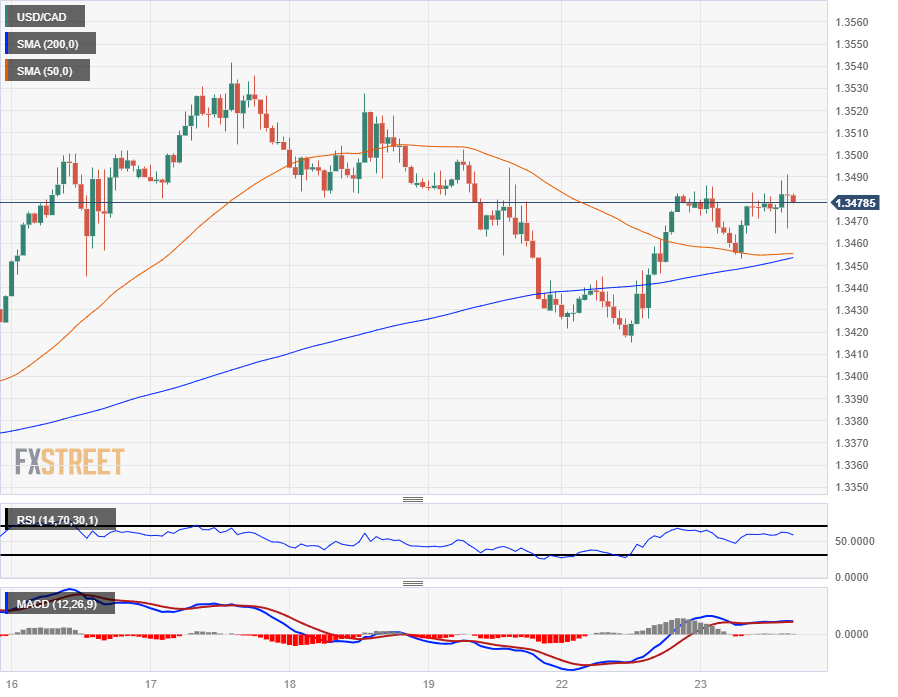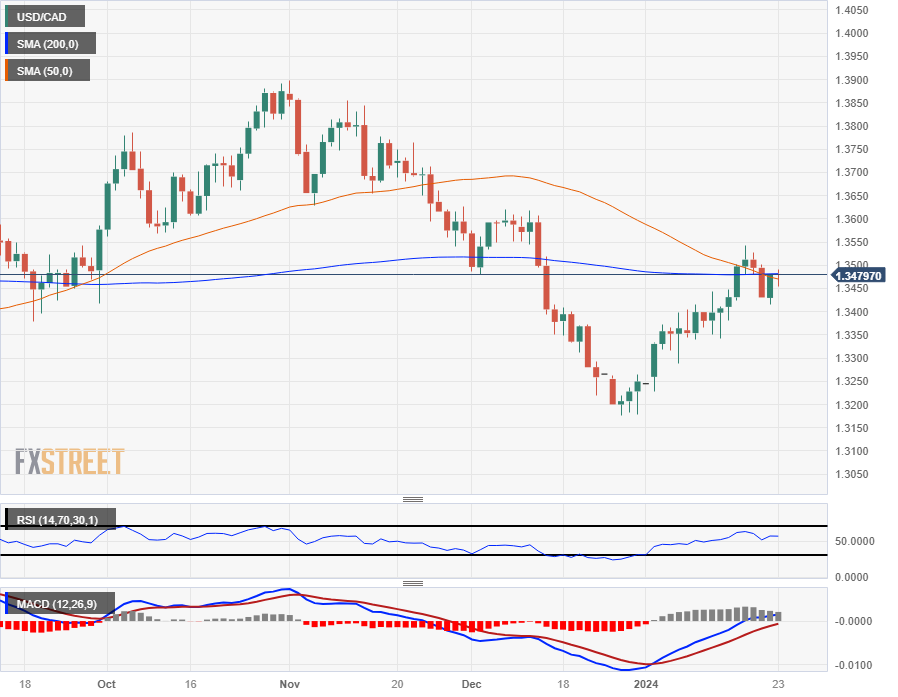- Canadian Dollar flows follow the broader market.
- On Wednesday, the Bank of Canada will announce interest rates.
- High oil prices support the CAD.
The Canadian Dollar (CAD) holds steady on Tuesday as market sentiment dictates the flow of CAD pairs, while Canadian Dollar traders prepare for the Bank of Canada's (BOC) latest rate call and the subsequent press conference. Crude oil markets are leaning higher heading into the middle of the week, keeping the Canadian Dollar supported and preventing pre-BoC pullbacks in the near term.
In Canada, new home prices stabilized in December and declined in annualized terms, but the Canadian housing bubble remains one of the worst in the G20 of developed economies, with housing affordability at its worst in more than four decades. Runaway housing prices are expected to slow economic growth and push the Canadian national economy into a recession in the first half of 2024.
Daily summary of market movements: The Canadian dollar operates sideways while waiting for the BoC
- The BoC statement on interest rates and monetary policy will be released on Wednesday, and the Canadian dollar will move lower ahead of the release of the central bank statement.
- CAD gains in Loonie pairs are due to weakness in comparable currencies.
- The Canada New Home Price Index stagnated at 0.0% in December, down from -0.2% the previous month.
- New home prices in Canada fell 0.9% in December, in line with the previous figure.
- Despite a short-term easing of house price growth in Canada, Canada has one of the worst housing affordability indices in the G20.
Bank of Montreal (BMO) Chief Economist Doug Porter noted that Canada has entered a recession shortly after the last three spikes in housing affordability.
- Crude oil prices trade higher on Tuesday, supporting the Canadian Dollar with US West Texas Intermediate (WTI) crude oil holding between $75.00 and $73.00 per barrel.
Canadian Dollar prices today
Below is the percentage change of the Canadian Dollar (CAD) against the currencies listed today. The Canadian dollar appreciated against the euro.
| USD | EUR | GBP | CAD | AUD | JPY | NZD | CHF | |
| USD | 0.36% | 0.25% | 0.00% | 0.02% | 0.16% | -0.04% | 0.20% | |
| EUR | -0.36% | -0.11% | -0.36% | -0.34% | -0.20% | -0.40% | -0.16% | |
| GBP | -0.25% | 0.11% | -0.26% | -0.24% | -0.10% | -0.30% | -0.06% | |
| CAD | 0.00% | 0.37% | 0.27% | 0.04% | 0.16% | -0.03% | 0.21% | |
| AUD | -0.02% | 0.34% | 0.23% | -0.03% | 0.14% | -0.06% | 0.18% | |
| JPY | -0.15% | 0.19% | 0.08% | -0.17% | -0.13% | -0.19% | 0.03% | |
| NZD | 0.02% | 0.38% | 0.29% | 0.03% | 0.05% | 0.18% | 0.23% | |
| CHF | -0.22% | 0.16% | 0.05% | -0.21% | -0.19% | -0.04% | -0.25% |
The heat map shows the percentage changes of the major currencies against each other. The base currency is chosen in the left column, while the quote currency is chosen in the top row. For example, if you choose the euro in the left column and scroll down the horizontal line to the Japanese yen, the percentage change in the box will represent EUR (base)/JPY (quote).
Technical Analysis: CAD gains ground while counterpart currencies lose weight
The Canadian Dollar (CAD) is supporting itself against the broader currency market on Tuesday as major CAD currencies falter heading into the midweek. The Canadian dollar advances four tenths against the euro (EUR), while gaining more than a quarter against the British pound (GBP) and the Swiss franc (CHF), as the European bloc's currencies wither on market sentiment .
The US dollar maintained its gains against the Canadian dollar, while the USD/CAD pair recorded intraday lows. The pair hit an intraday low of 1.3453 before bouncing within Tuesday's opening bid range at 1.3478.
On Monday, the GBP/USD pair bounced off the 200-hour SMA near 1.3415, and the pair remains bullish awaiting headlines from Wednesday's mid-week session.
The USD/CAD pair remains trapped in technical congestion between the 50-day and 200-day SMA, with price action consolidating near the 1.3450 to 1.3500 area. The pair is currently trading up 2.3% from December's swing low at 1.3177.
USD/CAD Hourly Chart

USD/CAD Daily Chart

Frequently Asked Questions about the Canadian Dollar
What factors determine the price of the Canadian dollar?
The key factors that determine the price of the Canadian dollar (CAD) are the level of interest rates set by the Bank of Canada (BoC), the price of oil, Canada's main export product, the health of its economy, inflation and the trade balance, which is the difference between the value of Canadian exports and its imports. Other factors are market confidence, that is, whether investors bet on riskier assets (risk-on) or look for safe assets (risk-off), with the risk-on being positive for the CAD. As its largest trading partner, the health of the US economy is also a key factor influencing the Canadian dollar.
How do Bank of Canada decisions affect the Canadian dollar?
The Bank of Canada (BoC) exerts significant influence over the Canadian Dollar by setting the level of interest rates that banks can lend to each other. This influences the level of interest rates for everyone. The BoC's main objective is to keep inflation between 1% and 3% by adjusting interest rates up or down. Relatively high interest rates are usually positive for the CAD. The Bank of Canada can also use quantitative easing and tightening to influence credit conditions, with the former being negative for the CAD and the latter being positive for the CAD.
How does the price of oil affect the Canadian dollar?
The price of oil is a key factor influencing the value of the Canadian Dollar. Oil is Canada's largest export, so the price of oil tends to have an immediate impact on the value of the CAD. Generally, if the price of oil rises, the CAD also rises, as aggregate demand for the currency increases. The opposite occurs if the price of oil falls. Higher oil prices also tend to lead to a higher probability of a positive trade balance, which also supports the CAD.
How does inflation data influence the value of the Canadian Dollar?
Although inflation has traditionally always been considered a negative factor for a currency, as it reduces the value of money, the opposite has actually happened in modern times, with the relaxation of cross-border capital controls. Higher inflation often leads central banks to raise interest rates, attracting more capital inflows from global investors looking for a lucrative place to store their money. This increases the demand for the local currency, which in the case of Canada is the Canadian Dollar.
How does economic data influence the value of the Canadian dollar?
The published macroeconomic data measures the health of the economy and may have an impact on the Canadian dollar. Indicators such as GDP, manufacturing and services PMIs, employment and consumer confidence surveys can influence the direction of the CAD. A strong economy is good for the Canadian dollar. Not only does it attract more foreign investment, but it may encourage the Bank of Canada to raise interest rates, resulting in a stronger currency. However, if economic data is weak, the CAD is likely to fall.
Source: Fx Street
I am Joshua Winder, a senior-level journalist and editor at World Stock Market. I specialize in covering news related to the stock market and economic trends. With more than 8 years of experience in this field, I have become an expert in financial reporting.







